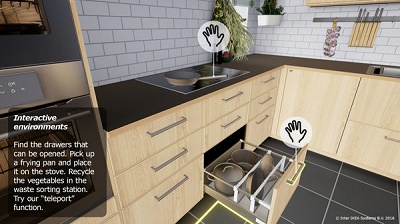IKEA is constantly experimenting with new technology while pioneering its own. Already the company has its own line-up of smart home technology and has thrown its weight behind wireless charging, but now the company is adopting virtual reality technology in a completely unique way.
Using the power of HTC’s Vive VR headset, IKEA is showcasing how customers will be able to take a peek of their brand new kitchens before they’re installed. While the App is currently being run as a test, it could give installers the opportunity to launch something similar.
Sometimes working with clients can be a difficult job – managing expectations for instance. Trying to explain exactly how the place will look is a challenging task; it’s why many installers now use 3D CAD software and design drawings to showcase exactly how the finished article will look. But what if VR became part of the picture?
“Virtual reality is developing quickly and in five to 10 years it will be an integrated part of people’s lives. We see that virtual reality will play a major role in the future of our customers. For instance, someday, it could be used to enable customers to try out a variety of home furnishing solutions before buying them,” says Jesper Brodin, managing director at IKEA of Sweden and range and supply manager at IKEA Group.
The IKEA VR Experience brings the user a virtual IKEA kitchen in real world size. Using an HTC Vive headset, consumers can use the App to explore one of three differently-styled kitchen room settings.
The user can change the colour of cabinets and drawers with a click or view the kitchen from different perspectives by either shrinking or stretching themselves to move around the kitchen at the size of a 3.3ft tall child or a 6.4ft tall adult. This could be useful for the user, since walking around the room in someone else’s shoes enables them to discover hidden dangers or possible design solutions.
“We also see IKEA VR Experience as an opportunity to co-create with people all around the world. We hope that users will contribute to our virtual reality development, by submitting ideas on how to use virtual reality and how to improve the virtual kitchen,” says Martin Enthed, IT manager for IKEA communications, the in-house communication agency at IKEA of Sweden.
The App was made in collaboration with developers at the French company Allegorithmic, using Unreal Engine 4 from Epic Games and has been developed for HTC Vive.
While IKEA has the budget to create a virtual reality App, Valve, the company behind the HTC Vive’s software, has already shown off many development tools which aim to make it easy for everyone to create their own App. Installers could one day design a home cinema or AV set-up from within Valve’s tools and showcase that set-up to their customers, enabling them to get a better idea of the finished product.
Unfortunately, the only problem with the HTC Vive is the fact that it needs to be tethered to a powerful computer. There’s no reason a similar solution couldn’t be developed for something like the Gear VR however, which utilises Samsung’s Galaxy smartphones to power its optics.


